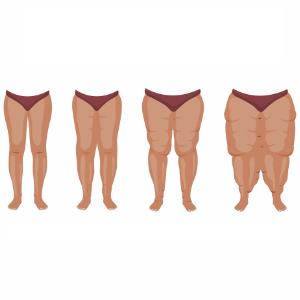Do you feel frustrated by changes in your legs or arms that diet and exercise just don’t seem to fix? Have you been told it’s ‘just Cellulite’, but you’re experiencing pain or swelling too? There is a possibility it could be Lipedema.
In this article we’ll go over the differences between Cellulite and Lipedema, to help understand these two conditions and find the right treatment.
Cellulite: The Common Culprit
Most of us know about Cellulite – those annoying dimples and lumps you often see on thighs, buttocks, and arms. It happens when fat pushes against the connective tissue under your skin. Cellulite is incredibly common and doesn’t pose any health risks. However, it can be a cosmetic concern for some.
Lipedema: A Deeper Issue
Lipedema is a less common medical condition that, in its early stages, can look a lot like Cellulite. Lipedema is an adipose tissue and loose connective tissue disorder, that causes an abnormal fat accumulation – usually in the legs, buttocks, and arms.
Unlike Cellulite, Lipedema involves painful fat nodules, swelling, easy bruising, and a heavy feeling in the affected areas. It’s not just about appearance – it can progress to a point where it significantly impacts your quality of life and makes everyday activities challenging.
- Key Differences:
- Cause: Cellulite is primarily a cosmetic issue related to how fat is distributed, while Lipedema is a medical condition with a different underlying cause that is not fully understood, but is believed to involve a combination of genetic and hormonal factors.
- Symptoms: Cellulite is painless, while Lipedema can cause pain, swelling, and mobility issues.
- Treatment: Cellulite treatments focus on appearance, while Lipedema treatments aim to manage symptoms, prevent progression, and improve quality of life.
Understanding the Stages of Lipedema
Lipedema is a chronic and progressive condition, meaning it can worsen over time without proper management. It primarily affects women and often begins around the time of puberty. Childbearing and menopause can increase the abnormal fat build up, and progress the stage of the condition. The cause of onset is believed to involve a combination of genetic and hormonal factors.
Here’s a breakdown of Lipedema stages:
- Stage 1: Early stage with subtle changes. You might notice small, pebble-like lumps under your skin and experience some pain or bruising.
- Stage 2: Fat nodules become larger and more noticeable, creating a dimpled or quilted appearance. You may start feeling heaviness in your legs.
- Stage 3: Fat buildup becomes severe, leading to a column-like or balloon-like appearance in the legs. Large folds of skin and fat can develop, making movement difficult.
- Stage 4: Lipedema combines with lymphedema, causing even more swelling and discomfort. Skin may become hardened and discolored.
Early Diagnosis & Treatment are Key
Catching Lipedema in its early stages is critical to prevent progression and manage symptoms more easily. If you suspect you have Lipedema, please consult with your doctor for a proper diagnosis.
How Manual Lymphatic Drainage and Myofascial Massage Can Help Early-Stage Lipedema
I’m a Licensed Massage Therapist specializing in Manual Lymphatic Drainage (MLD) and Myofascial work that can benefit individuals with early-stage Lipedema (stages 1 and 2). My approach involves integrating lymphatic drainage with several massage and myofascial techniques:
- MLD: Reduces fluid buildup and supports the lymphatic system to eliminate waste that has collected in the tissues .
- Massage: Stimulates circulation and brings fresh nutrients to affected areas.
- Myofascial Release, which may also include Cupping & IASTM: Improves mobility and reduces pain, and may help break down fat nodules and improve tissue health.
My goal with this work is always to reduce fluid accumulation and pain levels. It should never be painful to receive, and I always work at your comfort level.
Beyond Lipedema: Benefits for Cellulite
Even if, after consulting with your doctor, it turns out to only be Cellulite, the good news is that the same massage techniques I use for Lipedema can be incredibly effective at improving the appearance of Cellulite, and promoting overall skin health!
Treating Late-Stage Lipedema (Stages 3 & 4)
Late-stage Lipedema requires treatment & management that is currently beyond my scope of practice. If you have late-stage Lipedema, I recommend seeking a Certified Lymphedema Therapist (CLT) who specializes in Complete Decongestive Therapy (CDT). I am very happy to refer you to a qualified therapist who can help.
Do you have further questions? Contact me today to discuss how Lymphatic Drainage and Myofacial Massage can be incorporated into your Lipedema or Cellulite management plan!

